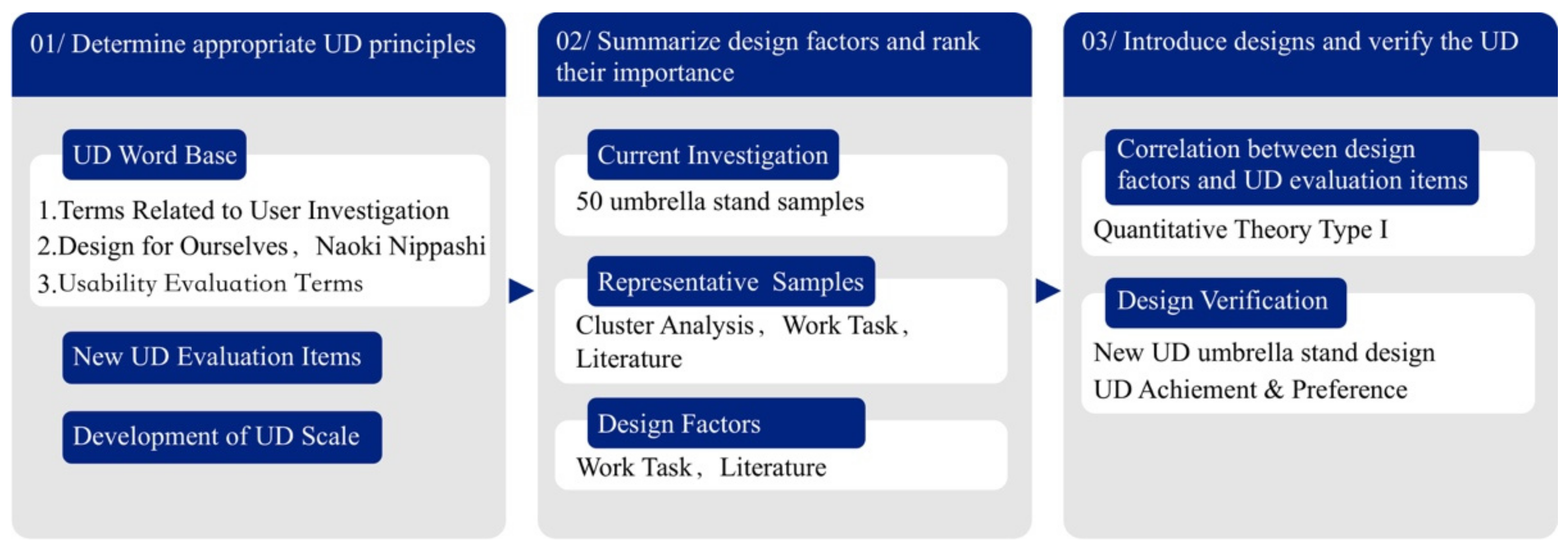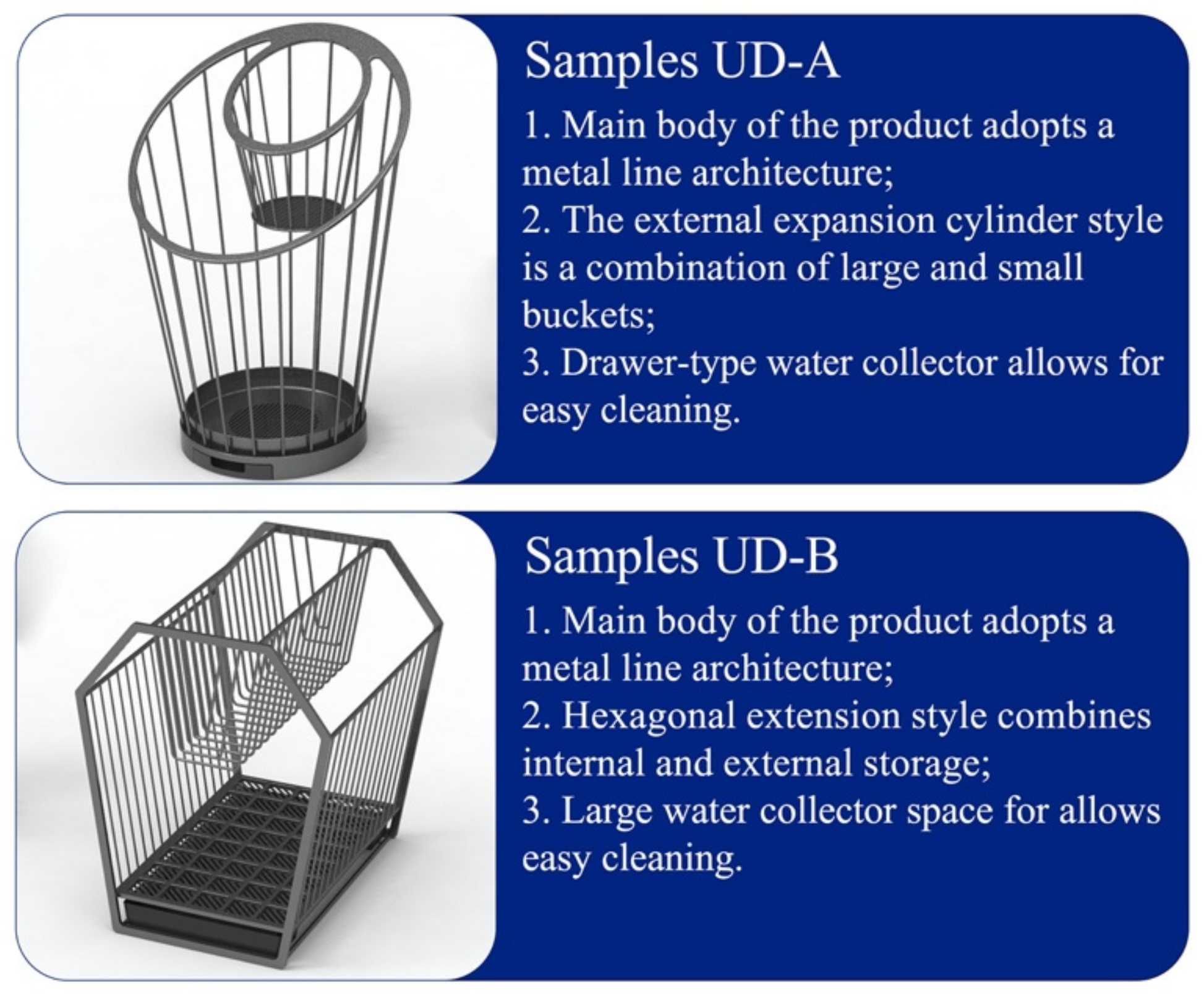The Strategy of Universal-Design Thinking in Architecturally Innovative Product Development
Abstract
:1. Introduction
- (1)
- To explore the development and application of appropriate UD scales for different products.
- (2)
- To discuss the diversification of architecturally innovative products and how inexact design factors are summarized and ranked by importance.
- (3)
- To develop a proper UD-introduction procedure and implement user verification of two umbrella-stand designs.
2. Research Objectives and Processes
2.1. Appropriate Adjustment of Universal-Design Scale to Product Type
2.2. Characteristics of Architectural Innovative Products
2.3. Process and Verification of Introducing Universal Designs into Architecturally Innovative Product Types
3. Research Methods and Experimental Procedures
3.1. Experiment 1 (Universal-Design Scale for Umbrella Stands)
3.2. Experiment 2 (Selection of Representative Experimental Samples and Design Factor Definition)
3.3. Experiment 3 (Introducing Universal Design into Product Development for Verification)
4. Results
4.1. Changes in Universal-Design Principles According to Product Characteristics
4.2. Summary and Importance Ranking of Umbrella-Stand Design Factors
4.3. Design Verification
5. Conclusions and Recommendations
Author Contributions
Funding
Institutional Review Board Statement
Informed Consent Statement
Data Availability Statement
Acknowledgments
Conflicts of Interest
References
- Keates, S.; Clarkson, J. Countering Design Exclusion; Springer: London, UK, 2004. [Google Scholar]
- Lin, K.C.; Wu, C.F. Practicing universal design to actual hand tool design process. Appl. Ergon. 2015, 50, 8–18. [Google Scholar] [CrossRef] [PubMed]
- Ostroff, E.; Preiser, W. Universal Design Handbook; MacGraw Hill: Boston, MA, USA, 2001. [Google Scholar]
- Sawada, K.; Fukano, S.; Sakayori, E.; Kosaka, M. Creation of a tool for universal design development evaluation UD-checker creation and examples of use. In Proceedings of the 2nd International Conference for Universal Design in Kyoto, Kyoto, Japan, 22–26 October 2006. [Google Scholar]
- Panasonic. Available online: http://www.panasonic.net/center/tokyo/floor/floor_03/index.html (accessed on 8 March 2010).
- Liu, Y.E.; Lee, S.T.; Kascak, L.R.; Sanford, J.A. The Bridge Connecting Theory to Practice—A Case Study of Universal Design Process. In Proceedings of the International Conference on Universal Access in Human-Computer Interaction, Los Angeles, CA, USA, 2–7 August 2015; pp. 64–73. [Google Scholar] [CrossRef]
- Newell, A.F.; Gregor, P. “User sensitive inclusive design”—In search of a new paradigm. In Proceedings of the 2000 Conference on Universal Usability, Arlington, VA, USA, 16–17 November 2000; pp. 39–44. [Google Scholar] [CrossRef]
- Sangelkar, S.; Cowen, N.; Mcadams, D. User activity—Product function association based design rules for universal products. Des. Stud. 2012, 33, 85–110. [Google Scholar] [CrossRef]
- Gual, J.; Lloveras, J.; Puyuelo, M.; Romero, F. A proposal of an evaluation model under the principles of universal design. In Proceedings of the International Design Conference—Design 2010, Dubrovnik, Croatia, 17–20 May 2010. [Google Scholar]
- Booz; Allen; Hamilton. New Products Management for the 1980s; Allen & Hamilton: New York, NY, USA, 1982. [Google Scholar]
- Henderson, R.M.; Clark, K.B. Architectural innovation: The reconfiguration of existing product technologies and the failure of established firms. Adm. Sci. Q. 1990, 9–30. [Google Scholar] [CrossRef] [Green Version]
- Demirbileka, O.; Demirkanb, H. Universal product design involving elderly users: A participatory design model. Appl. Ergon. 2004, 35, 361–370. [Google Scholar] [CrossRef]
- Wu, C.F.; Lin, K.C.; Yang, C.Y.; Liao, S.F. The influence of relationship between distinct hand tools and universal design scales with screwdriver. J. Des. 2016, 21, 25–34. [Google Scholar]
- Afacan, Y.; Erbug, C. An interdisciplinary heuristic evaluation method for universal building design. Appl. Ergon. 2009, 40, 731–744. [Google Scholar] [CrossRef] [Green Version]
- Kawauchi, Y. Universal Design—Questions for Barrier Free; Gakugei Publishing: Kyoto, Japan, 2001. [Google Scholar]
- Bendixen, K.; Benktzon, M. Design for All in Scandinavia—A strong concept. Appl. Ergon. 2015, 46, 248–257. [Google Scholar] [CrossRef]
- Japan Ergonomics Society. The Universal Design Practical Guidelines; Kyoritsu Shuppan Co., Ltd.: Tokyo, Japan, 2007. [Google Scholar]
- Clarkson, P.J.; Coleman, R. History of Inclusive Design in the UK. Appl. Ergon. 2015, 46, 235–247. [Google Scholar] [CrossRef]
- Story, M.F. Maximizing usability: The principles of universal design. Assist. Technol. 1998, 10, 4–12. [Google Scholar] [CrossRef]
- Iwarsson, S.; Ståhl, A. Accessibility, usability and universal design—Positioning and definition of concepts describing person-environment relationships. Disabil. Rehabil. 2003, 25, 57–66. [Google Scholar] [CrossRef]
- Takeishi, A.; Fujimoto, T. Modularisation in the auto industry: Interlinked multiple hierarchies of product, production and supplier systems. Int. J. Automot. Technol. Manag. 2001, 1, 379–396. [Google Scholar] [CrossRef]
- Ulrich, K. The role of product architecture in the manufacturing firm. Res. Policy 1995, 24, 419–440. [Google Scholar] [CrossRef] [Green Version]
- McAdams, D.A.; Kostovich, V. A framework and representation for universal product design. Int. J. Des. 2011, 5, 29–42. [Google Scholar]
- Petersen, C.J. House Beautiful: The Organized Home: Stylish Storage Solutions for Every Room; Hearst Books: New York, NY, USA, 2008; p. 222. [Google Scholar]
- Bjork, E. Many become losers when the universal design perspective is neglected: Exploring the true cost of ignoring universal design principles. Technol. Disabil. 2009, 21, 117–125. [Google Scholar] [CrossRef]
- Kostovich, V.; McAdams, D.A.; Moon, S.K. Representing user activity and product function for universal design. In Proceedings of the International Design Engineering Technical Conferences and Computers and Information in Engineering Conference, San Diego, CA, USA, 30 August–2 September 2009; Volume 49057, pp. 83–100. [Google Scholar] [CrossRef]
- Wood, K.L.; Jensen, D.; Bezdek, J.; Otto, K.N. Reverse engineering and redesign: Courses to incrementally and systematically teach design. IJEE 2001, 90, 363–374. [Google Scholar] [CrossRef]
- Hirtz, J.; Stone, R.B.; McAdams, D.A.; Szykman, S.; Wood, K.L. A Functional Basis for Engineering Design: Reconciling and Evolving Previous Efforts. Res. Eng. Des. 2002, 13, 65–82. [Google Scholar] [CrossRef]
- Story, M.F. 7 defining criteria: A set of seven principles developed by the Center for Universal Design can help designers make their designs universal. Innov.-Mclean Va. 1997, 16, 29–32. [Google Scholar]
- Nippashi, N.; Aoki, M.; Otake, S.; Kishi, C.; Terauchi, F. New concept and its methods of designing with ordinary citizens–design for OURSELVES. In Proceedings of the 2nd International Conference for Universal Design in KYOTO, Kyoto, Japan, 22–26 October 2006. [Google Scholar]
- Hoehle, H.; Aljafari, R.; Venkatesh, V. Leveraging Microsoft’s Mobile Usability Guidelines: Conceptualizing and Developing Scales for Mobile Application Usability. Int. J. Hum. Comput. Stud. 2016, 89, 35–53. [Google Scholar] [CrossRef] [Green Version]
- Bloch, P.H. Seeking the ideal form: Product design and consumer response. J. Mark. 1995, 59, 16–29. [Google Scholar] [CrossRef] [Green Version]
- Ferketich, S.; Muller, M. Factor analysis revisited. Nurs. Res. 1990, 39, 59–62. [Google Scholar] [CrossRef]
- Field, A. Discovering Statistics Using SPSS; Sage Publications: Los Angeles, CA, USA, 2009. [Google Scholar]
- Tabachnick, B.G.; Fidell, L.S.; Ullman, J.B. Using Multivariate Statistics; Pearson: Boston, MA, USA, 2007. [Google Scholar]
- Nunnally, J.C. Psychometric theory. Am. Educ. Res. J. 1978, 5, 83. [Google Scholar]
- Nakagawa, S. (Ed.) Textbook for Universal Design; Long Sea Int’l Book Co.: Taipei, Taiwan, 2006. [Google Scholar]
- Beecher, V.; Paquet, V. Survey instrument for the universal design of consumer products. Appl. Ergon. 2005, 36, 363–372. [Google Scholar] [CrossRef]
- Mougenot, C.; Bouchard, C.; Aoussat, A.; Westerman, S. Inspiration, images and design: An investigation of designers’ information gathering strategies. J. Des. Res. 2008, 7, 331–351. [Google Scholar] [CrossRef] [Green Version]





| Umbrella Stand Design Factors | Type | |||
|---|---|---|---|---|
| Level 1 | Level 2 | Level 3 | Level 4 | |
| Water collector | Form | Merged | Separation | - |
| Putting umbrella | Hole of umbrella | Yes | No | - |
| Quantity | 5–8 | 9–12 | 13–16 | |
| Whole | Material | Rubber | Plastic | Metal |
| Style | Geometric | Organic | - | |
| Structure | Line | Plane | Solid | |
| Operation | Method | Insert | Insert and put | - |
| CUD and Mace’s 3B Principles | Satoshi Nakagawa [37] | The UD Principles Proposed in This Study |
|---|---|---|
| Equitable use | Anyone can use the product equitably | Product consideration for individuals and society (Subitem 1) Communication of social and cultural values (Subitem 2) Product usage feedback (Subitem 3) Product attractiveness (Subitem 4) Adjustability |
| Flexibility in use | Enable use through various methods | Product usability (Subitem 1) Safety considerations (Subitem 2) Operability (Subitem 3) User demand satisfaction |
| Simple and intuitive use | Use is simple and easy to understand | Product appearance characteristics |
| Perceptible information | Can use multiple sensual organs to understand message | Product added value |
| Tolerance for error | Improper use of the product will not cause accidents, and the product can be returned to its original shape | Combinations |
| Low physical effort | Reduce physical burden on users | Costs |
| Size and space for use | Ensure convenient size and space for use | Familiarity |
| Optimal design | Supplement 1 Durability and economics | - |
| Beauty | Supplement 2 Quality and aesthetics | - |
| Good business | Supplement 3 Health and environment | - |
| UD Principles for Consumer Products [38] | UD Principles for Needle-Nose Pliers [2] | UD Principles for Screwdrivers [13] | UD Principles Proposed in This Study |
|---|---|---|---|
| Energy conservation | User functional requirement satisfaction (product-design characteristics) | Fairness and functionality | Product consideration for individuals and society (Subitem 1) Social and cultural value communication (Subitem 2) Product usage feedback (Subitem 3) Product attractiveness (Subitem 4) Adjustability |
| Susceptibility | Psychological, spiritual, and social user self-actualization needs | Information perception and usability (product-design characteristics) | Product usability (Subitem 1) Safety considerations (Subitem 2) Operability (Subitem 3) User demand satisfaction |
| Flexibility | Commercial value | Experience and commercial value | Product-appearance characteristics |
| Adjustability | Task completion degree | Durability and economic efficiency | Product added value |
| Intuition and usability | Space and environmental considerations | Ease of operation | Combinations |
| Accessibility | Tolerance | Adjustability | Costs |
| Ease of operation | Adjustability | Tolerance | Familiarity |
| Fairness | - | - | - |
| Safety | - | - | - |
| Tolerance | - | - | - |
| Product size | - | - | - |
| Umbrella Stand Design Factors | Type | Type Scores | Partial Correlation Coefficient | |
|---|---|---|---|---|
| Water Collector | Form | Merged | −0.430 | 0.781 |
| Separation | 0.323 | |||
| Putting Umbrella | Hole of Umbrella | Yes | −0.063 | 0.344 |
| No | 0.157 | |||
| Quantity | 5–8 | −0.441 | 0.816 | |
| 9–12 | 0.275 | |||
| 13–16 | 0.386 | |||
| Whole | Material | Rubber | −0.597 | 0.831 |
| Plastic | −0.155 | |||
| Metal | 0.337 | |||
| Style | Geometric | 0.014 | 0.059 | |
| Organic | −0.019 | |||
| Structure | Line | 0.343 | 0.832 | |
| Plane | −0.485 | |||
| Solid | −0.403 | |||
| Operation | Method | Insert | −0.135 | 0.245 |
| Insert & Put | 0.101 | |||
Publisher’s Note: MDPI stays neutral with regard to jurisdictional claims in published maps and institutional affiliations. |
© 2021 by the authors. Licensee MDPI, Basel, Switzerland. This article is an open access article distributed under the terms and conditions of the Creative Commons Attribution (CC BY) license (https://creativecommons.org/licenses/by/4.0/).
Share and Cite
Gao, C.; Lin, K.-C.; Wu, Z.-Y. The Strategy of Universal-Design Thinking in Architecturally Innovative Product Development. Processes 2021, 9, 2254. https://doi.org/10.3390/pr9122254
Gao C, Lin K-C, Wu Z-Y. The Strategy of Universal-Design Thinking in Architecturally Innovative Product Development. Processes. 2021; 9(12):2254. https://doi.org/10.3390/pr9122254
Chicago/Turabian StyleGao, Chenhui, Kai-Chieh Lin, and Zheng-Yi Wu. 2021. "The Strategy of Universal-Design Thinking in Architecturally Innovative Product Development" Processes 9, no. 12: 2254. https://doi.org/10.3390/pr9122254
APA StyleGao, C., Lin, K.-C., & Wu, Z.-Y. (2021). The Strategy of Universal-Design Thinking in Architecturally Innovative Product Development. Processes, 9(12), 2254. https://doi.org/10.3390/pr9122254






